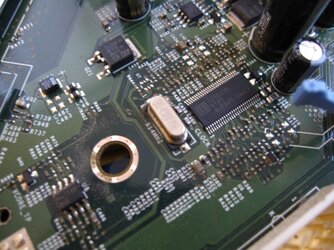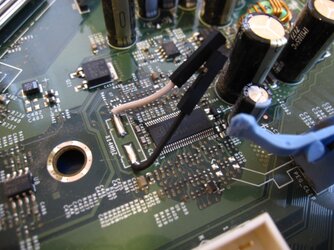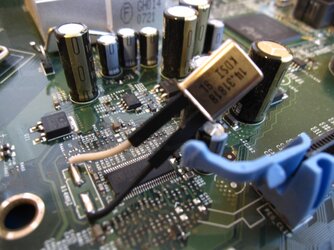- Joined
- Dec 12, 2015
- Location
- North Carolina, USA
Hello all,
I was recently given back an older machine that I had rescued and repaired (translation: salvaged from a tech dump and patched up, specs below) as a spare machine for my parents' living room a couple years back. They said that it had become too slow for them, and that I could do either of two things with it: scrap it, or make it faster somehow. According to them, they don't really care one way or the other, so this machine is to be considered 100% expendable in any efforts to make it faster.
I started by doing the obvious: changing out the old HDD for a small SSD I had lying around. The machine is really only used for internet browsing and watching movies, so the decrease in size should not be an issue. The old HDD seemed to be unusually grindy/noisy as well, so I suspect that it was probably on its last legs anyway. This resulted in a pretty significant boost to performance, but I want to go further.
Having finished that, the old core 2 processor and DDR2 RAM in this machine are my next point of concern. Basically, I want to see if I can overlclock them somehow, but that isn't going to be straightforward using the stock Dell Mobo and BIOS. Unfortunately, these old Dell prebuilts have an alternate-side mounting for the motherboard and a non-standard cooler mounting arrangement, and I don't feel like getting a new 775 socket motherboard, new case, and new cooler just for this project. My idea was this: change out the reference crystal on the motherboard and see if I could overclock it the old-fashioned way.
Unfortunately, my initial tests have not been successful so far.
I was able to locate the 14.318 MHz reference crystal and unsoldered it with no difficulties. I then tacked down a pair of leads so that I could easily swap out the crystals as needed for my experiments (see image). sticking in another 14.318 MHz crystal as a control test was sucessful: the machine still boots up and runs as normal, and I was even able to run P95 without any problems. However, any attempts to change the crystal to a value other than 14.318 MHz results in the machine hanging at the BIOS. I have tried 12MHz and 16MHz crystals so far (2.01GHz and 2.68GHz final CPU clock, repsecitively), and both have proven unstable even though 12MHz is technically lower than the stock value. Unfortunately, crystals like this are generally only available in a handful of standard frequencies, and even small changes to the base frequency will result in big jumps in the final CPU clock, so these are my options for crystal frequencies to try in this range (short of putting in values even farther out like 10MHz or 20MHz).
My question is this: is it even possible to overlclock modern machines in this way? so far, my experiments seem to indicate no, but would anyone know of any way to make this stable? maybe I'm doing something wrong? This machine should probably be able to handle some mild overclocking (the stock Dell cooler actually doesn't seem terrible and should be able to handle the heat, the VRMs I'm not too sure). The junk PSU may be an issue as well, but that would not account for the failure when underclocked at a 12MHZ reference.
Specs:
CPU: Intel Core 2 E6600 @2.4GHz
MOBO: MODIFIED Dell Optiplex 745 Mobo
Cooler: Dell 745 stock cooler (6 heatpipe w/ 140mm fan)
GPU: ATI Radeon X1300/X1550 (?)
PSU: stock Dell 300W PSU
RAM: 4x2GB DDR2 800MHz
SSD: 120GB PNY CS1211 (was previously 500GB Seagate HDD)
Case: Stock Dell optiplex 745 case
OS: Windows 7



I was recently given back an older machine that I had rescued and repaired (translation: salvaged from a tech dump and patched up, specs below) as a spare machine for my parents' living room a couple years back. They said that it had become too slow for them, and that I could do either of two things with it: scrap it, or make it faster somehow. According to them, they don't really care one way or the other, so this machine is to be considered 100% expendable in any efforts to make it faster.
I started by doing the obvious: changing out the old HDD for a small SSD I had lying around. The machine is really only used for internet browsing and watching movies, so the decrease in size should not be an issue. The old HDD seemed to be unusually grindy/noisy as well, so I suspect that it was probably on its last legs anyway. This resulted in a pretty significant boost to performance, but I want to go further.
Having finished that, the old core 2 processor and DDR2 RAM in this machine are my next point of concern. Basically, I want to see if I can overlclock them somehow, but that isn't going to be straightforward using the stock Dell Mobo and BIOS. Unfortunately, these old Dell prebuilts have an alternate-side mounting for the motherboard and a non-standard cooler mounting arrangement, and I don't feel like getting a new 775 socket motherboard, new case, and new cooler just for this project. My idea was this: change out the reference crystal on the motherboard and see if I could overclock it the old-fashioned way.
Unfortunately, my initial tests have not been successful so far.
I was able to locate the 14.318 MHz reference crystal and unsoldered it with no difficulties. I then tacked down a pair of leads so that I could easily swap out the crystals as needed for my experiments (see image). sticking in another 14.318 MHz crystal as a control test was sucessful: the machine still boots up and runs as normal, and I was even able to run P95 without any problems. However, any attempts to change the crystal to a value other than 14.318 MHz results in the machine hanging at the BIOS. I have tried 12MHz and 16MHz crystals so far (2.01GHz and 2.68GHz final CPU clock, repsecitively), and both have proven unstable even though 12MHz is technically lower than the stock value. Unfortunately, crystals like this are generally only available in a handful of standard frequencies, and even small changes to the base frequency will result in big jumps in the final CPU clock, so these are my options for crystal frequencies to try in this range (short of putting in values even farther out like 10MHz or 20MHz).
My question is this: is it even possible to overlclock modern machines in this way? so far, my experiments seem to indicate no, but would anyone know of any way to make this stable? maybe I'm doing something wrong? This machine should probably be able to handle some mild overclocking (the stock Dell cooler actually doesn't seem terrible and should be able to handle the heat, the VRMs I'm not too sure). The junk PSU may be an issue as well, but that would not account for the failure when underclocked at a 12MHZ reference.
Specs:
CPU: Intel Core 2 E6600 @2.4GHz
MOBO: MODIFIED Dell Optiplex 745 Mobo
Cooler: Dell 745 stock cooler (6 heatpipe w/ 140mm fan)
GPU: ATI Radeon X1300/X1550 (?)
PSU: stock Dell 300W PSU
RAM: 4x2GB DDR2 800MHz
SSD: 120GB PNY CS1211 (was previously 500GB Seagate HDD)
Case: Stock Dell optiplex 745 case
OS: Windows 7




 . I agree that there is a real issue in that overclocking by this method is going to overclock practically everything across the board, including the PCI bus and other parts not really intended to be messed with like this. Finding out where the signal paths are will probably involve doing a bit of research and a lot of staring intently at the traces on my mobo...
. I agree that there is a real issue in that overclocking by this method is going to overclock practically everything across the board, including the PCI bus and other parts not really intended to be messed with like this. Finding out where the signal paths are will probably involve doing a bit of research and a lot of staring intently at the traces on my mobo...